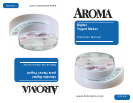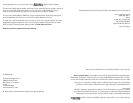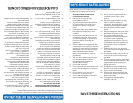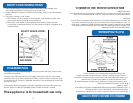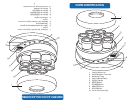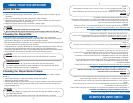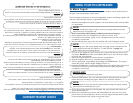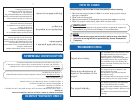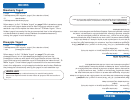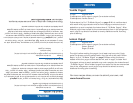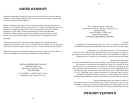
4
1. Read all instructions and important safeguards.
2. Remove all packaging materials and make sure items are received in good
condition.
3. Tear up all plastic bags as they can pose a risk to children.
4. Wash the yogurt maker lid, sealable cups and leak-resistant cup lids in warm,
soapy water. Rinse and dry thoroughly.
5. Wipe the yogurt maker body clean with a damp cloth.
USING YOUR YOGURT MAKER
Before First Use:
Choosing the Proper Milk:
The milk used is an important factor when making yogurt. For best results:
• Regular or organic pasterurized whole, low-fat or skim milk are all fine choices,
but must be brought to a near boil before being activated.
• Milk should be boiled to eliminate any additional bacteria. Allow the boiled milk
to cool to eliminate any skin that may develop.
• If using milk that has been sterilized at an ultra-high temperature (UHT), milk will
not need to be boiled before use and will result in a f
irm, skinless yogurt.
• Powdered milk works very well. Yogurt made with powdered milk is very smooth.
• Unflavored soy milk is also an excellent choice for making yogurt.
HELPFUL HINT:
• Whole milk will result in yogurt that is smoother and more aromatic.
• For thicker yogurt, add two to three tablespoons of powdered milk to the
milk used, taking care to mix it in completely.
Choosing the Proper Starter Culture:
You will need a starter culture in order to make yogurt. A starter culture can be
found in:
• A plain store-bought yogurt (preferably whole milk yogurt)
• A previously home-made yogurt
• A freeze-dried yogurt culture, which can be purchased at many pharmacies or
health food stores. If using a freeze-dried yogurt culture add two hours to the
yogurt making time.
NOTE:
• Do not use abrasive cleaners or scouring pads.
• Do not immerse the yogurt maker body, cord or plug in water at any time.
NOTE:
• Do not use a batch of yogurt more than ten times for the starter culture as
the results will diminish.
• For best results, use a starter culture and milk with similar fat contents.
NOTE:
• For best results, use a starter culture and milk with similar fat contents.
4
1. Lea todas las instrucciones y las medidas de seguridad.
2. Deshágase de los materiales de empaque y cerciórese que todos los aditamentos
vengan en buenas condiciones.
3. Deshágase de todas las bolsas de plástico, ya que pueden ser nocivas para los
niños.
4. Lave la tapa o cubierta del Utensilio Preparador de Yogurt, así como las tazas
selladas con sus tapas, en agua jabonosa y caliente y séquense bien.
5. Pase un paño húmedo por las cubiertas de todos los aditamentos y accesorios.
COMO USAR SU APARATO
Antes de usarse por primera vez:
Seleccionando la leche indicada:
La leche es un factor sumamente importante cuando prepare sus yogurt. Para r
esultados óptimos:
• Seleccione leche entera (Whole) o desnatada y baja en calorías (Low-Fat)
• La leche orgánica debe de hervirse para eliminar bacterias. Permita que se
enfrié para deshacerse de las natas.
• Si utiliza leche que ha sido esterilizada a muy altas temperaturas, no debe de
hervirse antes de usarse y le ofrecerá un yogurt firme y sin natas.
• La leche en polvo funciona muy bien para nuestros propósitos. El yogurt hecho
con leche en polvo le ofrecerá un producto muy fino y terso.
CONSEJO ÚTIL:
• La leche entera le resultará en yogures más suaves y aromáticos.
• Para un yogurt mas espeso, agregue dos o tres cucharadas de leche en polvo
a la leche que está usando, y mézclela a conciencia.
Seleccionando el cultivo indicado:
Va a necesitar de un cultivo para hacer yogures, y éstos puedes encontrarse en:
• Cualquier tienda donde vendan yogures (preferiblemente un yogurt de leche
entera).
• Un yogurt previamente elaborado en casa.
• Un cultivo de yogurt desecado al vacío, el cual puede conseguirse en muchas
farmacias o tiendas de alimentos saludables. Si usa un cultivo de yogurt desecado
al vacío, agréguele dos horas al tiempo estimado.
NOTA:
• No utilice limpiadores o trapos raspantes.
• No sumerja en agua el cuerpo del utensilio, sus cordones o el enchufe.
NOTA:
• No utilice una hornada de yogurt más de diez veces ya que los resultados del
cultivo pueden disminuir.
• Para mejores resultados, use un cultivo y leche con los mismos contenidos de
grasa.
NOTA:
• Para mejores resultados, use un cultivo y leche con los mismos contenidos de
grasa.



